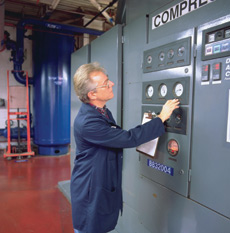Easier said than done
Moving operations offshore is more complicated than generally perceived according to Marty Weil
When the Wall Street Journal reported in December that IBM is planning to
move nearly 5,000 jobs to India, China, and other countries from the United
States, it was seen by many as the richest symbol yet of the great and
inevitable manufacturing migration driven by cheap labor and the need to
minimize operating costs. While this impulse cannot be denied, moving operations
offshore represents a more complex and risky venture than many may consider.
“My sense is that 10 years to 15 years ago when you thought about offshore
manufacturing, you thought ‘cheap, maybe inferior, but maybe good enough,’” says
Rudy Puryear, director of Bain & Company’s IT practice in the Midwest.
Boston, MA-based Bain is one of the world’s leading global business consultants.
“Over the last decade, the complexity of offshore production has gone up
dramatically; and at the same time, manufacturers have been trying to optimize
total delivered cost and manufacturing flexibility. But they aren’t yet
realizing the total delivered costs they expected.”
According to Puryear,
there are two principle reasons for this: underestimating the costs of doing
business overseas, and difficulties building in manufacturing flexibility.
“Labor rates aren’t as stable as management thought they would be,” he
continues. “We’re seeing wage inflation in India now, though not yet in China.
Further, many production dimensions are difficult to control, including shipping
costs.”
Volatile market demands add to the complexity. Offshore production
facilities are typically structured to build a very specific product, but with
product lifecycles shrinking dramatically, the question is how flexible is the
facility in adapting to the changes in products that are dictated by the market.
“Unless an organization has good control of all production elements, they can
get caught in a very difficult situation,” Puryear says. The fact that those
difficulties may rear their heads on the other side of the globe only
complicates matters.
According to Norbert Ore, chairman of the Manufacturing
Business Survey Committee at the Institute for Supply Management in Tempe, AZ,
any purchasing agent can tell you that continuity of supply is the most
important objective for any company bringing product to market. “When you look
at a supply chain that’s 12,000 miles long, you’re introducing variability that
you don’t have with a more compact supply chain,” he says. “Companies need to be
careful about assignment and they must do a thorough risk management analysis
about the resources they’re going to use from India and China.” 
Ore says the
Institute’s monthly survey of manufacturers have yielded comments more focused
on whether to make certain products or product lines in India or China (i.e.,
outsource the manufacturing) than on considering closing a plant here and
opening a plant there. “In terms of site selection, manufacturers should only
look to set up a factory in China if they want to market their product in
China,” says Ore. Otherwise they should outsource.
Why? First of all, the
cultural issues are tremendous according to Ore. Also, there isn’t a court
system based on precedents, so consistency of legal interpretation may be
lacking. “It’s left to bureaucrats, and standards shift with bureaucratic
whims,” he says. Ore does say this situation has improved recentlyˇthe Chinese
authorities and business community are aware of itˇbut nonetheless, local
culture remains the key.
According to Sung Won Sohn, executive vice
president and chief economic officer at San Francisco-based Wells Fargo Bank,
this need for local knowledge is precisely why the issue of partner selection is
critical. “The fact is that you need a good partner in China,” says Sohn. “It’s
still not easy to do business there, and the rules and regulations, and the
importance of local authorities, favor having a local partner.”
Sohn
emphasizes that not all businesses going to China are successful; some have lost
technology and money, and have come back to the United States after their forays
east. “You must go there with your eyes wide open,” he cautions.
Security is
also an issue, particularly for companies looking to establish their own sites
in China or India. “I would identify security issues as the number one barrier
to moving operations overseas,” says John H. Boyd, president of The Boyd
Company. This Princeton, NJ, consultancy specializes in helping organizations
expand and relocate. “Clients are experiencing a reluctance on the part of their
key personnel to travel internationally to certain offshore cities,” says Boyd.
This tendency has grown significantly since the 9/11 tragedy, and also with
events like the SARS outbreak in Asia.
Intellectual property issues are also
a security concern. “There can be severe problems with protecting intellectual
property,” says Martin Kenney, professor of human and community development at
the University of California, Davis. “For this reason, Intel doesn’t produce
semiconductors in any developing nation, and concerns about intellectual
property may mitigate against manufacturers moving to India or China.”
Nonetheless, the incentives are compelling for manyˇand drawn clearly on the
bottom line. According to Sohn, the manufacturing wage for 2002 in the United
States was $21 an hour; in Mexico, it was $2.33 an hour; in China, only $0.61 an
hour. “What’s driving site selection is the cost of doing business,” says Boyd.
“Comparative economics are ruling the site selection process, and companies are
putting qualitative factors on the back burner and leading with quantitative
ones.”
Additionally, and perhaps surprisingly, the availability of skilled
labor is also an incentive for companies frustrated by the tight availability of
skilled labor in the United States. “China produces more engineers than Japan,
the United States, and Europe combined on an annual basis,” says Sohn.
Wheeling, IL-based Glentronics, a manufacturer of backup sump pumps and
lighting devices for the plant and home, stands as an example of a smaller
company that has had great success in
producing goods overseas. “As a
company, we do not have a factory that we own,” says Alan Schulman, president of
Glentronics. Echoing Ore, Schulman says that one of the first things a company
must address is the length of the supply line when manufacturing overseas.
“When we plan production, lead times are three months to six months
depending on the product,” he explains. “If that production were domestic, those
lead times would be one to two months. So we had to extend everything, including
financing. First, we increased our funding to manage larger inventories and
asked for longer terms from contract manufacturers overseas.”
Glentronics
maintains dual production of the electronic controller that’s key to their
signature back-up pumps. Some are manufactured in China, some in Illinois; both
contract manufacturers follow Glentronics’ procedures to the letter. The final
assembly is done in the United States. “For me to get this finished product made
in China would be impractical,” says Schulman. “On the other hand, there are a
few products we market that are completely manufactured in China. Each project
is analyzed for what makes senseˇand the total delivered cost is the key. I call
it ‘blending of cost’ and ‘blending of products’ from all over the world to get
a finished product at a reasonable retail price.”
According to Schulman, the
pressure from retail outlets to maintain costs, even in light of rising material
prices, is forcing manufacturers to look to Asia, given that the only area to
lower costs is labor and assembly. He notes that if the Chinese were to let the
won float, the direction of manufacturing outsourcing would shift again.
The
cultural issues that many experts cite as a barrier to doing business have not
frustrated Schulman. “I’ve gone from having no desire to manufacture overseas to
having great respect for those with whom I manufacture there,” he says. “They
have a very high work ethic and are able to get complex projects executed. I’m
not building a factory, but I am building a detailed and complex product.”
According to Boyd, as the American economy picks up, the pace of offshore
investment is likely to slow. “Right now manufacturers are blinded by the cost
of doing business,” he says. “In a healthier economy, site selection will shift
to more of a quantitative/qualitative mix.”
Ore says that declining
manufacturing in the United States needs to be looked at through the lens of
productivity. “The number of manufacturing jobs is declining, but maybe
manufacturing isn’t,” he says. “Just look at the productivity numbers. After
World War II, the average product had a labor component of 55 percent; now there
is less than 10 percent labor in manufactured products. We have become much more
efficient.”
Ore contends that if the labor content of a product is high,
chances are its manufacture will move to Asia; if not, if there is more
value-added content, the likelihood is that the manufacture will remain in the
United States.
Boyd cites another possibility: the emergence of Canada as a
compelling alternative to China and India. “Canada is a known entity,” he says.
“Canadians share a common language, common business practices, and have no
tariffs.” With Canada, there is a lower security risk and greater political
stability. The exchange rates are very favorable, and the cost of fringe
benefits is significantly lower due to Canada’s national healthcare system.
The Boyd Company has recently completed a corporate site selection study
that compares the cost of operating a typical manufacturing plant in Providence,
RI, and 49 other U.S. and Canadian locations. Total operating costs range from a
high of $15.3 million in San Jose, CA, to a low of $7.4 million in New
Brunswick, Canada. (Annual operating costs in Providence were $9.5 million.)
“For companies that conclude that Asia is problematic, who don’t have the
human resources wherewithal, and don’t want to bear the training costs,
interpersonal issues, legal uncertainties, and other cultural outlays, Canada
may prove very attractive indeed,” concludes Boyd.






